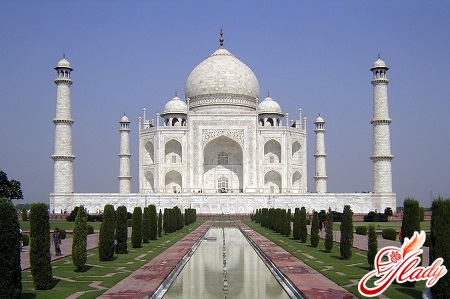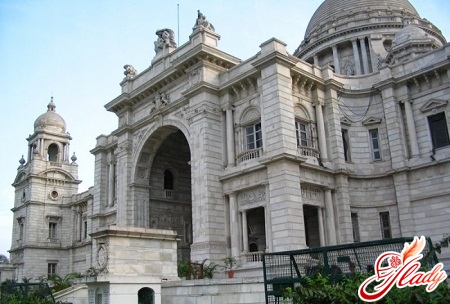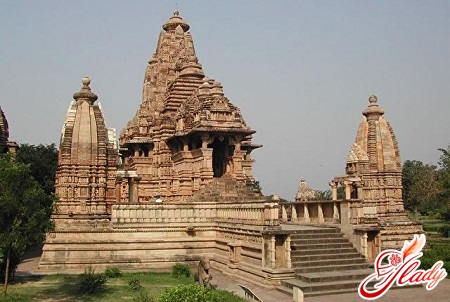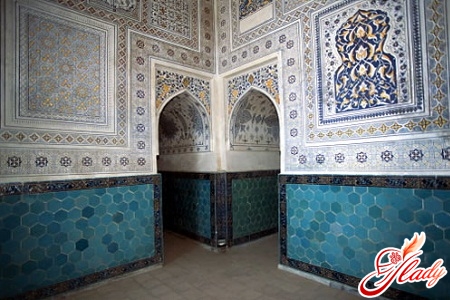
A famous proverb says:"A fish seeks where it is deeper, but a man seeks where it is better." For some incomprehensible reason, eluding the superficial glance, the people of India believe that this better will definitely come, but not now, not in this life, but in the next. And even then not by itself, but only if you live this life with dignity and correctly.
Sights of India: Rishikesh
It is a sacred city that every devoteeHinduism should visit at least once in a lifetime, if, of course, he wants to break free from the wheel of deaths and births and plunge into the waters of the sacred Ganges. There are always thousands of pilgrims on its streets, tens of times more than the locals. It is incomprehensible how all these people fit here, where they live and what they eat. In this city you can walk along a road that, as everyone deeply believes, can make a person better. Lakshman Jhula - Lakshman Bridge, is the only one of the main shrines of Rishikesh. About a hundred years ago, this bridge was built by the British. But this is not the point, but the fact that it was here at this place that Rama's brother Lakshmana crossed the sacred Ganges River and meditated for a long time. It was in this place that he pacified his anger, so above the bridge the Ganges is stormy, and below it smoothly carries its waters into the valley and further into the ocean. Everyone who comes to Rishikesh must cross this bridge and calm their anger. All day long, pilgrims walk along the narrow streets of the city, all of India is here, all the dozens of peoples inhabiting it. You can study the ethnography of this country by their clothes and jewelry. English is considered the official language here, but ordinary people rarely understand it. In the crowd of pilgrims there are many sad - holy people, ascetics. They are respectfully called babas, which means "respected". You can meet Hanuman - the legendary leader of the monkey army. To receive his blessing is considered a very good sign. Having met him, you need to take your earlobes with both hands and squat a little, imitating a monkey, he will be very pleased and will give his blessing. Rishikesh is also famous for its ashrams. There are about 30 large ashrams, and countless small ones. An ashram is a spiritual school where there is always a teacher and his followers who live with him and listen to the teachings. When you meet an ashram teacher, you need to touch his leg. Ask the ashram: "Why do I live?" He will answer: "Life is given to achieve bliss, to comprehend the divine mysterious essence. Everything earthly is perishable. It is a shell, just an appearance." Rishikesh is also considered the capital of yoga. Finding a yoga guru here is easy. And starting the day with a yoga lesson is the most correct thing that can come to mind. Yoga translated from Sanskrit means "union, unity". This is a meeting of the god Shiva with the goddess Shakti, male and female energy. The right side of the body is male, and the left is female. This is how the yogis of India explain why our right eye is not like the left, and the left leg is not like the right. And when the female and male energies meet, they rush to the cosmic source of energy. And all feelings become fuller and brighter after this meeting.
Sights of India: temples
The Taj Mahal is the calling card of India,известная всему миру. С его идеальными пропорциями и белоснежной мраморной утонченностью, его вычурной инкрустацией, он считается непревзойденным идеалом красоты. Храм был построен в качестве свидетельства любви. Шах-Джахал построил его во имя своей жены Мумтаз-Махал, которая умерла, дав жизнь их четырнадцатому ребенку. Когда она умирала, то взяла с него слово, что он построит для нее самый красивый в мире мавзолей. И хотя у Шах-Джахала было около пяти тысяч наложниц, он безумно любил только свою жену и готов был выполнить ее последнюю волю. Его мастера вырезали из драгоценных камней цветы и другие формы, бережно высекая тончайшие узоры из нефрита, лазурита, янтаря, яшмы и аметиста и затем инкрустировали ими белый мрамор. Исторические храмы Раджи Раджи Великого Но есть еще более древние достопримечательности Индии, спрятанные в ее тропических джунглях. Здесь один из самых грандиозных подвигов в области строительства за всю историю человечества породил тысячу причудливых и загадочных храмов. На самом юге Индии, в сердце традиционной культуры и религии, более тысячи лет тому назад величайший царь Индии Раджа Раджа Великий взялся за осуществление грандиозного строительства в истории человечества, продолжающегося и поныне. Он и его последователи истратили больше камня, чем ушло на строительство пирамиды Хеопса, а его художники создали величайшие в истории произведения архитектуры. Этот храм настолько просторный, что в его стенах могут спокойно разместиться двести Тадж-Махалов. И все это ради сил и символов веры. Самый первый из построенных храмов Раджа Раджи находится в Танджоре. Его строительство закончилось около тысячи лет назад. На то время он считался величайшим храмом в Индии и в десятки раз превосходил по высоте все предыдущие постройки. Но его достопримечательность не только в размере, но и в том, что он полностью построен из гранита — самого прочного камня на Земле. Личность Раджи Раджи Великого Она запечатлена по всему храму. Внутри него, под куполом гигантской башни, возвышается гигантский фаллос, линга, высотой 3,5 метра и 1,5 метра в диаметре. Линга является символом самого могущественного и любимого бога индийцев — бога Шивы. Линга олицетворяет могущество и плодовитость царя Раджи. И этот линга самый большой в Индии. Купол башни высотой 65 м и состоит из двух массивных гранитных блоков, каждый весом в 40 тонн. Трудно себе представить, как можно было поднять на такую высоту камень весом в 40 тонн в 1010 году нашей эры! И только нынешний принц Танджора раскрыл тайну того, как поднимали камни на такую высоту. Их поднимали по склону под углом 6 градусов, который вели к вершине, а длина скола была более двух километров. Такие склоны называют в индии пандусами. Все здания и храмы построены лицом на восток туда, где встает солнце. И все найденные остатки пандусов построены с запада на восток, что подтверждает эту теорию. Еще одна достопримечательность Индии, а именно армии Раджи Раджи, являются слоны. Ведь именно войнами с ближайшими соседями и добывал царь средства на строительство храма. Но слоны вносили свой вклад не только в боях. Именно они толкали по пандусу гранитные блоки по идеально круглым балкам. Они же перекладывали балки вперед для следующего толчка. Остается загадкой и то, как высекали и добывали самый твердый камень на Земле. Немного позже полка мусульман положили конец династии Раджи Раджи. Мусульмане уничтожали всякое свидетельство индуизма. Священники закапывали и замуровывали в потайных комнатах золотые божества, инкрустированные бриллиантами, за которыми мусульмане и охотились. Божества пролежали в песке более 700 лет, пока их не обнаружили в 1905 году. И это стало величайшей археологической находкой века. Но после нашествия мусульман Индия поднялась на еще более величественные высоты. 
The city is a magnificent winner
The central part of southern India is now largerresembles a rural area, with sun-baked earth and great piles of granite boulders. But once upon a time there was a great and prosperous city on this site. Its people looked back to the golden age of Raja Raja and created an otherworldly city, one that Raja Raja himself could not have imagined. Several centuries later, after Raja's temples had been swallowed by the jungle, a mysterious and holy city arose, the city of Vijayanagara, the conquering city. Founded in 1350, it was built in just 30 years and was larger than any European city, with a population 50 times greater than that of medieval London or Paris. Its founders set themselves the task of continuing the traditions of art and architecture. Carved granite frescoes decorating the courtyard introduce the lifestyle of the rich and famous. The traditions of Vijayanagara, left by the king, are hunting, dancing girls and wrestling. There were many artificial pools in this city, and every day all the inhabitants held ritual baths. The city was full of game boards. Dozens of different games were carved into the stones everywhere, and it is therefore not surprising that chess was invented in India. The game of chaturanga was played by the kings of Vijayanagara to hone their fighting skills. The elephant is the prototype of the rook, the strongest piece that could move in all directions and even jump over weaker pieces. This force was a reflection of the indomitable power of elephants, which was present in war, construction, and economy. And again, the Muslim invaders destroyed this city too. It was a battle of Allah against a hundred gods of India to establish supremacy, to break the faith. The city was almost completely destroyed and is now considered a ghost town, in which no one has ever settled. But the south rose again, building even more magnificent and majestic temples, the pearl of which is Madurai, the most graceful of all Indian temples. But despite this, out of a hundred people who come to India, only ten go to the south to admire these magnificent temples. The central temple is the abode of the gods, and it was considered improper to build it in any other way than modestly. But often with a gilded roof crowning the temple. Temples now began to expand more and more, for it was no longer possible to increase their height. This expansion led to the creation of gates decorated with ornaments and called gopuras. The wings of Madurai are especially graceful and replete with sculptures. On the gate alone there are more than a thousand individual figures. In our time, the temple authorities regularly paint them in their bright original colors. Words are not enough to describe what we saw.
The indisputable and magnificent Srirangam
The most majestic temple is, without a doubt,Without a doubt, Srirangam. It is so large that it could comfortably accommodate the Kremlin, the US Senate, the British Parliament, and still have room for the Palace of Versailles and St. Peter's Basilica in Rome. And here, bronze relics are still worshipped, hymns are sung that are more than a thousand years old, and a connection is maintained with a culture that goes back to the time of Raja Raja. But for most of the world, and for many in India, it is all a lost and forgotten world. So why are these temples, the legacy of Raja Raja, ignored by Western society? Part of the answer lies in what happened here in February 1838, when a British officer, Captain William Berg, discovered the lost castles. He was told of wonders to be found in a place called Khajuraho, abandoned for centuries and hidden under dense canopy of trees. The worst came when he got close enough to see what was depicted on the temple walls. The temple walls were decorated with scenes of group sex, with aroused men and lusting women. This was not what a good Christian would expect to see on the walls of a house of worship. However, in Hinduism, things are very different. One of the many goals of Hinduism is the pursuit of love, and Hindus see nothing wrong with depicting love scenes on the walls of their temples. But these temples shocked the Western visitor, who was once again convinced of his moral superiority. The nature of Hinduism had become too extreme for the Victorians. It was because of the Victorian sense of propriety that the temples and art of southern India were ignored by tourists and scholars. A world that was as culturally advanced as Greece and as architecturally advanced as the ancient Egyptians had disappeared into the jungle again, becoming a lost world.









